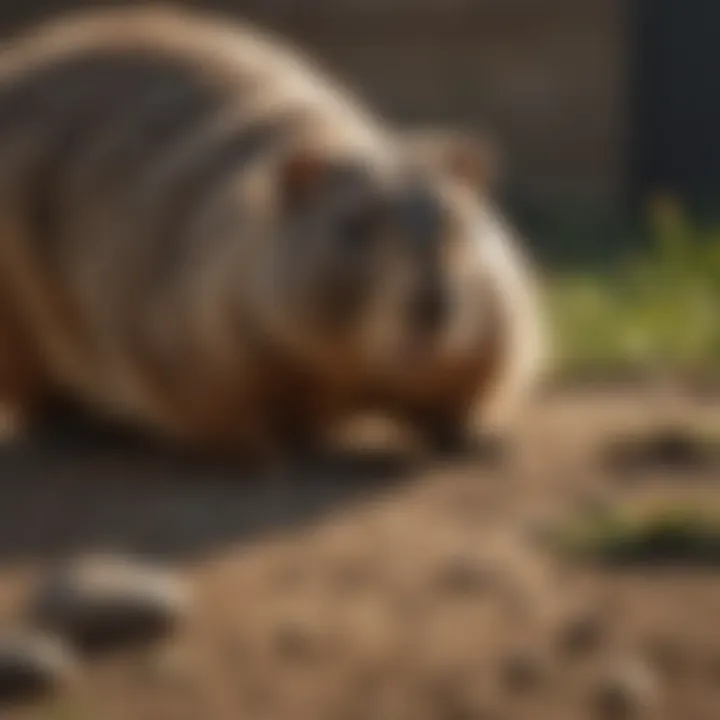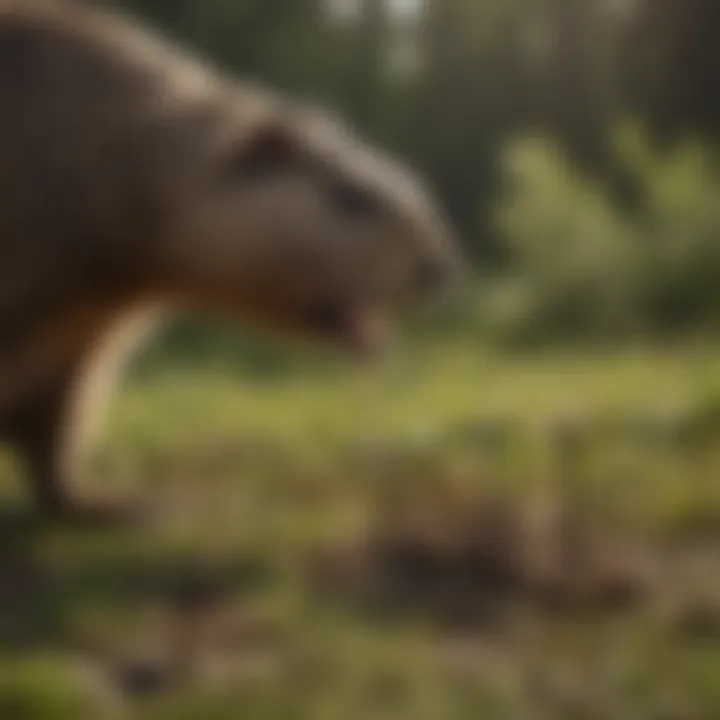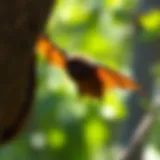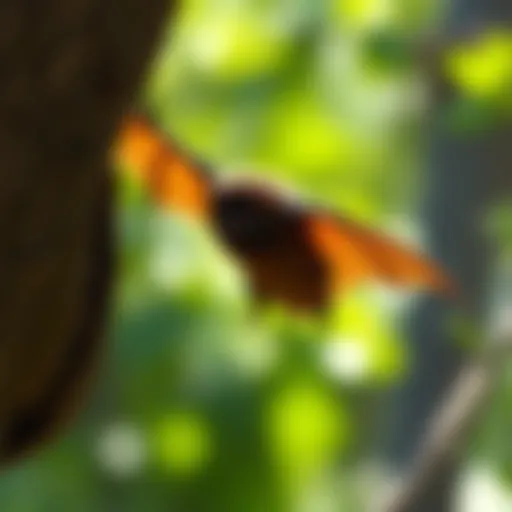Effective Strategies for Groundhog Deterrent Spikes


Intro
Groundhogs, also known as woodchucks, are notable residents in many gardens and agricultural areas. Their burrowing habits and appetite for various plants can turn a beautiful garden into a barren landscape. In response to this challenge, the introduction of groundhog deterrent spikes as a pest control method has gained attention. This article delves into effective strategies, focusing on the practicality and effectiveness of these spikes. By understanding how these devices work and integrating them into broader pest management approaches, homeowners can better protect their properties from groundhog damage.
Understanding Pests
Groundhogs are classified as pests primarily due to their destructive feeding habits and their tendency to dig extensive burrowing systems.
Definition of Pests
Pests are organisms that harm humans, their property, or the environment. This includes insects, rodents, and other wildlife, which can disrupt gardens and crops. Understanding what constitutes a pest is the first step in effective pest management.
Importance of Pest Identification
Identifying the specific pest species is crucial in developing an effective control strategy. This identification will inform what methods are most appropriate for managing groundhogs. Misidentifying a pest can lead to ineffective solutions or unnecessary use of harmful chemicals. Proper identification can save both time and resources. By recognizing that groundhogs are responsible for the damage in gardens, homeowners can focus on targeted strategies, such as the deployment of deterrent spikes.
Prevention Techniques
Preventing groundhogs from entering gardens is much more effective than trying to remove them after they have established a presence. Various strategies can be implemented to deter them proactively.
Home and Garden Preventative Measures
- Fencing: Installing a fence that is at least five feet tall and buried a foot underground can prevent groundhogs from burrowing into the garden.
- Barrier Plants: Certain plants are less appealing to groundhogs. Using these to form a natural barrier can reduce their attraction.
- Regular Maintenance: Keeping gardens tidy and free of debris can discourage pests.
Seasonal Prevention Tips
- Spring: Start the season with a thorough garden clean-up. Remove any dead plant material that may attract pests.
- Summer: Monitor for signs of groundhog activity and reinforce barriers if necessary.
- Fall: Trim back overgrown vegetation to minimize hiding spots for groundhogs preparing for winter.
- Winter: Regularly check your garden for any potential burrowing activity as winter approaches.
Eco-Friendly Pest Control Solutions
For eco-conscious homeowners, sustainable pest control solutions are essential. These methods tend to be less invasive to the environment while still addressing the pest problem effectively.
Overview of Sustainable Practices
Sustainable practices focus on prevention, habitat manipulation, and the use of non-toxic products. Groundhog deterrent spikes fit well within this framework. They can deter groundhogs using physical barriers rather than chemicals.
Natural Remedies and Their Effectiveness
In addition to deterrent spikes, several natural remedies have shown potential in repelling groundhogs.
- Spicy Repellents: Capsaicin-based sprays can deter groundhogs while being harmless to the environment.
- Castor Oil: This oil can cause an unpleasant sensation for groundhogs if applied regularly.
By combining these methods with deterrent spikes, homeowners can create a comprehensive pest management strategy.
"Effective pest management requires understanding pest behavior and using a combination of strategies tailored to specific challenges."
Prelude to Groundhog Deterrent Strategies
Groundhogs, also known as woodchucks, can pose significant challenges for homeowners and gardeners. They are notorious for their burrowing habits, which can lead to structural damage and loss of crops. Implementing effective pest control strategies, such as groundhog deterrent spikes, is therefore crucial. These spikes not only deter groundhogs but also provide a humane method for managing their populations.
Understanding the behavioral patterns of groundhogs is the first step in developing an effective deterrent strategy. Knowledge of their habits allows individuals to tailor their approaches, ensuring maximum effectiveness. Moreover, the importance of combining different pest management strategies cannot be overstated. Groundhog deterrent spikes work best when integrated with other methods, creating a holistic approach to pest control.
Understanding Groundhog Behavior
Groundhogs are herbivorous creatures, primarily known for their diet of grass, vegetables, and fruits. They are most active during dawn and dusk. This active period is critical for determining the timing and placement of deterrent devices. Knowing when groundhogs are likely to invade your property allows for strategic planning in your pest control efforts.
Moreover, groundhogs tend to establish territories and are less likely to venture far from their burrows. By studying their routines, homeowners can effectively position deterrent spikes in areas of frequent activity. This localized approach increases the chances of repelling groundhogs while minimizing unnecessary disruption to the garden or property.
The Importance of Pest Deterrence


Deterrence is an essential part of pest management. The goal is to create an environment that is unwelcoming to pests. Utilizing groundhog deterrent spikes plays a significant role in this regard. These devices do not harm the animals but discourage them from creating a habitat nearby.
There are multiple benefits to pest deterrence. First and foremost, it protects plants and vegetation from being consumed or damaged. Additionally, it reduces the chances of structural damage caused by burrowing activities. A proactive approach to pest deterrence can save homeowners time, money, and headaches down the line.
"Proactive measures in pest management, like using deterrent spikes, save significant costs related to property damage and crop loss."
By understanding the significance of these strategies, homeowners can more effectively implement them and create a less hospitable environment for groundhogs. Ultimately, the combination of understanding their behavior and the importance of pest deterrence lays the groundwork for successful control measures.
What are Groundhog Deterrent Spikes?
Groundhog deterrent spikes are tools specifically designed to manage groundhog populations. These devices play a key role in pest control by physically discouraging groundhogs from digging and burrowing in certain areas. Given the persistent nature of these rodents, using deterrent spikes can create a more effective and long-lasting solution. These spikes act as a barrier, steering groundhogs away from gardens, lawns, and other areas where they can cause damage.
Understanding the construction and design of these spikes will provide insight into why they work effectively against groundhog behavior. Additionally, exploring the various types of deterrent spikes reveals the options available to homeowners looking to implement this strategy. The choice of material is important and can influence both the effectiveness and longevity of the spikes.
Construction and Design
The construction and design of groundhog deterrent spikes vary significantly among different types. Most spikes are designed to be robust and spike into the ground, creating an uncomfortable surface for groundhogs. The spikes must be sharp enough to deter the animals without causing permanent injury. Typically, they are elevated so that when the groundhog attempts to dig, it encounters the spikes before making significant progress. This design can be a critical factor that determines the effectiveness of the deterrent.
Types of Deterrent Spikes
Deterrent spikes can be categorized based on the materials used in their construction. The choice of material impacts both durability and the overall effectiveness of the spikes. Common types include:
- Metal Spikes
Metal spikes are a popular choice due to their strength and longevity. They can withstand weather conditions without degrading. One key characteristic of metal spikes is their sharpness, which can effectively deter groundhogs. Moreover, they do not bend or break easily, thus providing a lasting solution. However, the potential rusting over time could be a disadvantage if not treated properly. Metal spikes often come with a painted or coated surface to minimize corrosion. - Plastic Spikes
Plastic spikes are lighter than metal and often easier to handle during installation. A key feature is their resistance to weather elements. They typically do not corrode, which can be an advantage in humid or wet environments. Because they are made from various polymers, they are designed to be sharp as well. However, the drawback is their lower durability compared to metal; they may break or bend under certain pressures. This can limit their effectiveness, particularly in high-traffic areas. - Composite Materials
Composite spikes consist of mixtures of materials aimed at providing robustness while reducing weight. One of their key characteristics is the balance of strength and flexibility, helping them resist breakage while also being easier to install. Composite spikes can also be resistant to various environmental factors, making them suitable for diverse climates. However, they can be more expensive than either metal or plastic options. Additionally, the long-term effectiveness compared to metal is still a point of contention.
In summary, groundhog deterrent spikes are vital for effective pest control in residential spaces. Knowing the construction, types, and their specifics allows homeowners to choose the right option for their needs.
Effectiveness of Deterrent Spikes
Understanding the effectiveness of groundhog deterrent spikes is central to employing them successfully in pest control. Groundhogs, also known as woodchucks, can cause extensive damage by burrowing and feeding on vegetation. Thus, determining how well these spikes function is vital for homeowners and landscapers alike. The main benefits of using deterrent spikes include reduced property damage, lower maintenance costs over time, and an environmentally friendly approach to managing pest populations.
Scientific Insights
Numerous studies indicate that groundhogs avoid areas where they encounter physical barriers. In essence, deterrent spikes create an environment that is less inviting for these creatures. A study conducted by the University of Vermont showed that groundhogs displayed a significant aversion to gardens protected by spikes as opposed to unprotected areas. This aversion can be attributed to their natural instinct to steer clear of potential hazards in their environment.
The design of these spikes plays a crucial role. For instance, metal spikes tend to be more effective due to their sturdiness and durability, while plastic spikes are lighter and may suit less severe cases. Furthermore, the placement of spikes informs their success rate; strategically located in entry points to gardens or near burrow sites can significantly enhance their effectiveness.
User Testimonials
Feedback from users offers invaluable insights into the practical use of groundhog deterrent spikes. Homeowners have reported a marked decrease in groundhog activity after installing these deterrents. One user noted, "After installing metal spikes around my vegetable garden, I hardly see any groundhogs anymore. They seem to have moved on to other areas."
Another testimonial emphasized the ease of installation: "It was straightforward to set up these spikes. I placed them near the burrow holes and within weeks, the groundhogs were gone."
However, not all experiences shine as brightly. Some homeowners felt the effectiveness varied depending on specific factors such as local wildlife and environmental conditions. A few reported minimal success, suggesting the need for a multidisciplinary approach that combines spikes with other pest management strategies. Ultimately, the consensus remains that deterrent spikes are a sensible choice when integrated thoughtfully with other methods.
Installation Guide for Groundhog Deterrent Spikes
The effectiveness of groundhog deterrent spikes significantly depends on proper installation. Understanding the specific steps and considerations helps maximize their impact on groundhog populations. This section highlights essential elements of installing these spikes, offering a comprehensive guide to ensure efficient pest control.
Selecting the Right Location
Choosing the right location for installing groundhog deterrent spikes is crucial. Groundhogs are habitual animals. They prefer certain areas that meet their needs. Look for locations near burrows, known feeding areas, or paths that the animals frequently use. A few considerations include:
- Observe Groundhog Activity: Spend time watching where the groundhogs tend to frequent. Look for signs of feeding, digging, or trails.
- Distance from Structure: Install spikes a safe distance from vegetable gardens or flower beds that you want to protect, but close enough to discourage groundhogs.
- Environmental Factors: Consider soil types and moisture levels. Spikes anchored into stable soil provide better deterrent effects than those in loose or wet soil.
Step-by-Step Installation
Implementing the following step-by-step guide will ensure proper installation of the deterrent spikes. Each step highlights practical actions necessary for effective placement:
- Gather Necessary Tools: Tools needed include a hammer or mallet, a measuring tape, and possibly a shovel for deeper installations.
- Identify Placement Spots: Based on your observations, mark placement spots where you will install the spikes. Ensure the spikes are spaced adequately to create a barrier.
- Prepare the Ground: Clear any debris or vegetation from the selected installation spots. Depending on the condition of the ground, slight digging may be necessary to make an appropriate hole.
- Install the Spikes: Drive the spikes into the ground, ensuring they are deep enough to maintain stability while also being protrusive enough to deter groundhogs. Follow the manufacturer's recommendations for depth.
- Test Stability: After installation, attempt to wiggle the spikes gently. They should be firmly anchored and unable to shift with slight pressure.
- Final Inspection: Once all spikes are installed, visually inspect them to ensure they are upright and spaced correctly.
Safety Considerations During Installation


Installing deterrent spikes requires adherence to some essential safety practices:
- Wear Appropriate Gear: Gloves are important for protection against sharp edges. Safety glasses may also be wise to protect against flying debris during installation.
- Avoid Overexertion: Use tools correctly and avoid excessive force that could lead to personal injury. Take breaks if needed to prevent strain.
- Be Aware of Surroundings: Before starting, check for obstacles and ensure the area is free of children or pets. This consideration helps minimize accidents during the installation process.
By adhering to the guidelines presented in this section, homeowners can more effectively deploy groundhog deterrent spikes, ultimately enhancing the pest control strategy and protecting valuable property.
Maintenance of Deterrent Spikes
Maintaining groundhog deterrent spikes is a vital part of ensuring their effectiveness in pest control. Regular upkeep not only prolongs the lifespan of the spikes but also maximizes their utility in repelling groundhogs and preventing property damage. Neglecting maintenance could result in reduced effectiveness or complete failure of the spikes. Therefore, understanding how to conduct regular inspections and cleaning becomes essential for homeowners.
Regular Inspections
Regular inspections of the deterrent spikes are crucial. These checks allow property owners to assess the physical state of the devices. Over time, weathering can affect spikes made from various materials, such as metal or plastic. Inspections help identify any rusting, bending, or breakage.
- Schedule inspections at least once a month, particularly during changes in seasons.
- Look for physical damages such as bumps or erosion.
- Evaluate the alignment of the spikes; they should stand vertically. Misalignment can lessen their effectiveness.
While inspecting, it is also important to keep an eye on the surrounding area. The presence of grass and other plants can sometimes hide the spikes. Trimming back vegetation around the deterrent spikes ensures that they remain visible and retain their functionality.
Cleaning Procedures
Cleaning the deterrent spikes is also an essential component of their maintenance. Built-up debris can hinder the spikes' ability to deter groundhogs effectively. Therefore, maintaining a clear space around these devices is recommended. Here are practical steps for cleaning:
- Use a soft brush to remove dirt, leaves, or animal remains from the spikes.
- Combine mild detergent with water for tougher grime, then wipe with a cloth.
- Rinse with water to ensure no soap residue remains.
Cleaning should be done at least twice a year, or more frequently, depending on environmental conditions. For instance, during rainy seasons, more frequent cleaning may be necessary due to the accumulation of mud and debris.
"Regular inspections and cleaning ensure that deterrent spikes remain effective and durable. Neglect leads to potential breakdowns in pest control strategies."
By keeping your groundhog deterrent spikes well-maintained, you can enhance your pest management efforts significantly. Investing a little time can lead to a substantial reduction in potential groundhog damage to your property.
Integrating Deterrent Spikes with Other Pest Management Strategies
Integrating groundhog deterrent spikes into a broader pest management strategy is essential for achieving effective control over groundhog populations. This approach recognizes that while deterrent spikes can be effective, they should not operate in isolation. Complementing their use with other strategies provides a more holistic solution to thwart these burrowing rodents from damaging gardens and properties.
Companion Planting Techniques
Companion planting is an ancient method used to deter pests while promoting plant growth. Certain plants can naturally repel groundhogs and other unwanted critters. For instance, planting marigolds around gardens is known to deter a variety of pests. Groundhogs tend to dislike certain aromatic plants such as garlic and rhubarb, making them beneficial companions in your garden.
In practice, this technique can be easily incorporated by strategically placing these plants near vulnerable crops. Not only does this create a natural barrier, but it also enhances biodiversity in the garden, which can lead to healthier plants overall. Ensure that these companion plants are native to your area, as they will flourish better and be more effective in deterring pests.
Using Natural Repellents
In addition to deterrent spikes and companion planting, utilizing natural repellents can enhance your pest control strategy. Many homeowners have found success with homemade repellents that rely on safe, non-toxic ingredients. For example, pepper spray—made by mixing ground red pepper and water—has shown efficacy in deterring groundhogs when sprayed around garden perimeters.
Moreover, products containing castor oil have been observed to discourage groundhogs, as the scent is unappealing to them. It's important to apply these natural repellents after rainfall or irrigation, as wet conditions dilute their effect. Regular application not only maintains the potency of the repellents but also reinforces their presence, making it less likely for groundhogs to intrude.
"Integrating different pest management strategies is key to creating sustainable agricultural practices that benefit both the garden and the environment."
By combining groundhog deterrent spikes with companion planting and natural repellents, homeowners can create a robust defense against groundhogs. This multi-pronged approach not only mitigates the potential for property damage but also fosters ecological diversity and sustainability.
Environmental Impact of Groundhog Deterrent Spikes
When considering groundhog deterrent spikes, it is vital to evaluate their environmental impact. Understanding how these devices influence the ecosystem is crucial for homeowners and landowners aiming to balance pest control efforts with environmental sustainability. This section highlights specific elements related to the environmental considerations of using groundhog deterrent spikes.
Sustainability Considerations
Groundhog deterrent spikes are designed to inhibit the movement of these rodents without causing harm. Their construction often includes materials like metal and plastics, which need to be assessed for sustainability. Biodegradability and recyclability are essential factors. These spikes should ideally be made from materials that can decompose over time or be recycled, reducing waste.
Key factors to consider include:


- Material Sourcing: Evaluate where the materials come from and whether sustainable practices were utilized.
- Longevity: More durable spikes reduce the need for frequent replacements.
- Energy Use: Examine the energy footprint involved in producing these spikes. Lower energy-intensive manufacturing processes contribute to sustainability.
By choosing environmentally friendly products, users can help mitigate any negative impacts on the ecosystem while effectively deterring groundhogs from gardens and yards.
Impact on Non-target Species
Another important aspect of groundhog deterrent spikes is their effect on non-target species. These devices are intended for groundhogs, but other wildlife could encounter them unintentionally. Therefore, understanding this potential impact is crucial to assure all animals' safety in the area.
Potential concerns include:
- Injury to Other Animals: Sharp spikes can harm birds or small mammals that might wander into an area where spikes are installed.
- Habitat Alteration: Installation may change the local habitat, affecting not just groundhogs but also other species that rely on the same environment.
Ensuring that deterrent spikes are placed strategically can help minimize risks to non-target animals. Setting them up away from natural habitats and heavily trafficked wildlife areas can greatly reduce the likelihood of unintended consequences.
"The use of groundhog deterrent spikes should prioritize both effective pest control and the protection of local wildlife. Balancing these aspects demonstrates responsible management practices."
In summary, the environmental impact of groundhog deterrent spikes is multifaceted. Homeowners should prioritize sustainable materials and ensure the safety of non-target species while implementing deterrent strategies. This approach will contribute to a healthy ecosystem and responsible pest management.
Addressing Common Misconceptions
Misconceptions surrounding groundhog deterrent spikes can lead to confusion among homeowners and gardeners. Understanding these misconceptions is crucial for making informed decisions about pest control methods. Proper knowledge can prevent unwarranted fears or doubts regarding the use of these devices.
By addressing these issues, we can clarify the intentions and functionalities of groundhog deterrent spikes. This section outlines two common misconceptions: the belief that these spikes are cruel and the concern that they may cause injury to animals or pets.
Are Deterrent Spikes Cruel?
The question of cruelty often arises in discussions surrounding pest control methods. Many people worry that the use of deterrent spikes is an inhumane approach. However, it is imperative to understand the purpose and mechanism behind these devices.
Groundhog deterrent spikes are designed primarily to prevent groundhogs from entering specific areas, not to inflict harm. These spikes provide a physical barrier that encourages groundhogs to avoid certain locations rather than engage with them.
The effectiveness of these spikes lies in their ability to protect gardens and properties without direct harm to the animals.
Here are some key points to consider:
- Behavioral Influence: Instead of targeting the animal, spikes act as a deterrent based on discomfort rather than injury.
- Non-Harmful Options: Many spikes are built from materials that do not easily injure. They are designed to nudge animals away rather than cause pain.
- Long-term Solutions: By using these spikes, property owners can create an environment where groundhogs are less likely to return, which ultimately promotes coexistence.
In this way, it is essential to view deterrent spikes as a means to manage rodent populations humanely, rather than a tool for cruelty.
Can Spikes Cause Injury?
Concerns about injury from groundhog deterrent spikes are common. Many individuals apprehend that these devices could pose a physical threat to not just groundhogs but also to pets or other wildlife. Addressing these fears requires a detailed look at how these spikes are constructed and their intended use.
While any physical structure can potentially cause injury if misused, groundhog deterrent spikes are generally safe when installed correctly and used as intended. Here are some considerations to ease these concerns:
- Design Factors: Most commercially available deterrent spikes feature blunt tips or are made from materials that do not easily inflict deep injuries.
- Strategic Placement: By carefully selecting where to place the spikes, homeowners can minimize risks to other animals. Installing them away from high-traffic areas for pets can help ensure safety.
- Physical Deterrent: The actual intent of these devices is not to injure, but to create an unfriendly environment for groundhogs. Thus, the goal remains to provide safe pest control solutions.
Ending
The conclusion serves a crucial role in encapsulating the primary insights shared throughout the article. This narrative has delved into the innovative use of groundhog deterrent spikes—a vital tool for homeowners and gardeners facing challenges with groundhog populations. Groundhogs, often seen enjoying gardens and lawns, can cause significant damage. Therefore, knowing effective strategies to deter them can save considerable time, effort, and resources.
Summary of Key Points
First, the article highlighted the significance of understanding groundhog behavior before implementing deterrent measures. Groundhogs are creatures with specific tendencies and preferences, which, when comprehended, allow for more effective management. Next, the essential construction and design of the deterrent spikes were discussed along with the distinct types—metal, plastic, and composite materials. Each type offers unique advantages and disadvantages, refining the choices available for different environments.
Furthermore, insights into the effectiveness of these spikes were provided, supported by scientific research and user testimonials. Such evidence showcases the positive impact that intentional installation and proper maintenance can have on repelling groundhogs. In addition, integrating these spikes with other pest management strategies can enhance control efforts significantly.
The article also addressed common misconceptions surrounding deterrent spikes, particularly their perceived cruelty and the risk of causing injuries to the animals. By clarifying these misunderstandings, readers are better equipped to discuss and decide on the use of these devices.
Finally, the importance of maintenance and regular inspections was emphasized to ensure the spikes function optimally over time. This ongoing commitment promotes longer-lasting results in keeping groundhogs at bay, thus protecting property.
Future Considerations in Pest Control
As pest management strategies evolve, there is a need to consider new methods and technologies. The future of pest control may incorporate the use of smart technology that allows for monitoring and adjustment of deterrent devices. Furthermore, as more homeowners value sustainable practices, combining spikes with eco-friendly pest management systems could lead to wider acceptance and use.
In summation, this article presents groundhog deterrent spikes as a practical and effective tool for pest control. By fostering a deeper understanding of their functioning and aligning them with other management strategies, homeowners can confidently face the challenges presented by these burrowing rodents. By continuously re-evaluating methods, homeowners will ensure their pest control efforts are both effective and ethically sound.
"Effective pest control balances practicality with humane methods to protect both property and wildlife."



